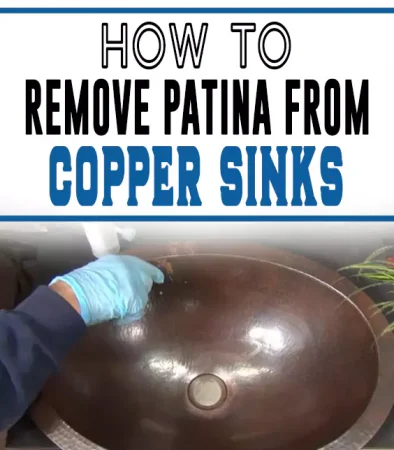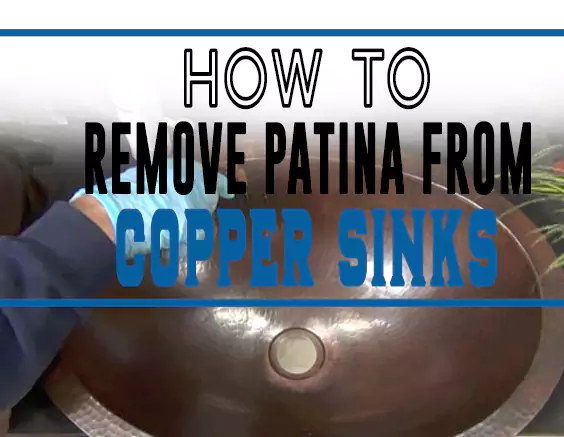Need to know how to remove Patina from copper sinks? Follow these methods and restore your sink to its original look.
Copper, when exposed to oxygen or a bunch of other chemical substances, it forms oxides like most other metals. Instead of rusting, it forms brown, or even bluish or green hues called patina.
Patina is a natural process of protection, so you can’t control its formation. The darker brown or black coloration of the patina covers the bright shiny surface of your copper making it less attractive and less reactive. But regular cleaning and maintenance can prevent this.
You can preserve the original luster and a consistent tone of your sink by removing patina from copper sinks. In this article, I’ll help you understand thoroughly how to remove the patina from copper sinks.

How to Remove Patina from Copper Sinks Using Dishwashing Soap
Step 1: Gather your Tools
Before you start, you should acquire some necessary tools and supplies. You will need a soft sponge to clean the sink surface. You can also use a microfiber or cotton dishcloth. Be sure to use a non-abrasive cloth or sponge.
Don’t use harsh scrubbers like steel wool or as they can cause damage to your copper sink. Use dishwashing liquid or cleaner without bleach or harsh chemicals.
Harsh cleaners can be tough on your sink and cause further damage. Also, avoid using drain openers.
Always use warm water to wash your sink to effectively remove the patina from copper. You can repeat this step daily for better cleaning and maintenance.
Step 2: Rinse Thoroughly
Start by rinsing the copper sink thoroughly to remove all the bits and pieces. After every use, rinse the sink thoroughly to remove any pieces of food or other products that may be latched onto your sink surface.
It is important to rinse properly to remove any acid and chemical residues. Do not let any acidic foods, i.e. mayonnaise, ketchup, pickles, and tomato sauce, stay on the copper surface for a long time. Always use warm or hot water for more effective results.
Step 3: Wipe Down with Dishwashing Soap
Squeeze some dishwashing soap on a wet soft sponge or a non-abrasive pad. Thoroughly wipe down the sink surface with a soapy sponge.
Don’t forget to wipe the sink rims as well. If you have a copper farmhouse sink, scrub the exposed apron as well. Daily repeat this step to keep the sink in the best shape.
Step 4: Rinse Again and Dry
Use warm water to rinse away the soap. After thorough rinsing, dry the sink with a clean dishcloth or towel. Drying the sink will prevent mineral accumulation and discoloration.
How to Remove Patina from Copper Sinks Using Baking Soda
Step 1: Prepare Baking Soda Mixture
Dishwashing soap isn’t enough to remove patina off copper sinks. You don’t need any expensive cleaners for this purpose. Simply make a mixture of baking soda and warm water.
Step 2: Apply the Mixture to Stubborn Patina Stains
Use a dishcloth to apply the mixture to all patina stains. Gently scrub the affected area for a few minutes.
If your sink is shiny and has an additional polish or finish, you can also add vinegar to the baking soda mixture. It can effectively clean patina from copper sinks.
The baking soda paste can also help eliminate green spots, commonly called verdigris. These spots are created by detailed exposure to moisture.
Step 3: Rinse off the Baking Soda Mixture
After cleaning, rinse the sink for a final time, of course using warm water. Use a lint cloth or towel to dry the sink as well as the fixtures.
Repeat the process if required. Instead of baking powder, you can also use lime and salt mixture for removing patina from copper sinks.
How to Remove Patina from Copper Sinks Using Copper Cleaner
To maintain your copper sink’s polish and shine, clean it with a copper cleaner. Simply apply the cleaner to a clean cloth. Use it to wipe the sink surface, then carefully rinse and dry the sink. Use a copper cleaner after every four to six weeks.
How to Remove Patina from Copper Sinks Using Copper Protectant
Using a copper protectant or wax is incredibly effective for copper sink patina repair. With this protectant, you can preserve the bright, shiny surface of your sink for a long period:
- Apply a minute amount of wax on a clean cloth and rub it onto the sink surface.
- Use a microfiber dishcloth or towel to buff the sink’s surface.
- Apply a copper wax or protectant after every six weeks.
Daily Care for Removing Patina from Copper Sink
Removing patina from the copper sink is easy, but proper care can also prevent the development of patina or any other stains on your sink:
- Take proper care of your sink by avoiding abrasive chemicals and scrubbers.
- Dry the sink after every use.
- Avoid leaving acidic foods in the sink.
- Don’t leave pots and pans in the sink for too long.
Patina Cleaning from Hammered Copper
Left on its own, copper naturally tarnishes. If you don’t want to see patina on your copper sink, you can consider these options:
1. Stay Away from Bleach
Do not use bleach or bleaching agents. This has been mentioned before in the steps for cleaning the copper sink, but it’s so important that it’s worth mentioning again.
Bleach can cause permanent discoloration on copper, so no matter how long the stain has been there or how bad you think it is, it’s never a good idea to use bleach.
2. Embrace Natural Change in Color or Use Lacquer
It’s completely normal for copper to be less shiny or to be darker over time. So if you notice discolorations like that, don’t worry too much. It’s part of the normal wear-and-tear process.
However, you can easily slow this process down by regularly waxing your sink or opting for a copper sink with a lacquered surface. This kind typically needs less waxing and does not lose its shine as easily.
Remember, however, that once you have lacquered up your sink, it’s there for good. You have, therefore, locked the copper in so to speak.
3. Use a Copper Cleaner
There are many copper creams available at local supermarkets today. You can use whatever is available to you.
Simply apply it all over the sink surface using a dry cloth. Allow it to sit for a few minutes (feel free to let it sit longer if the patina is bad) and then buff it up using the same dry cloth until it is shiny.
Some copper cleaners may have specific instructions for use. Be sure to follow them.
4. Apply a Protective Cream
Just as with copper cleaners, protective products for copper surfaces now abound. Pick a copper protectant of choice, lather it on dry, clean, sink, and leave it on as a surface coating.
This will prevent patina from forming in the future. Be sure to follow the instructions on how often you will need to reapply the coating to make the most of the product.
How to Remove Hard Water Stains from Copper Sinks
Water is considered hard if it has a higher concentration of dissolved minerals i.e. magnesium, phosphorus, and calcium. Mostly these elements get mixed by the groundwater when it passes from soil and rocks.
Excessive use of hard water cause mineral deposition on the sink surface. If this mineral accumulation is not removed and cleaned properly it can leave greenish stains, the fading luster of your sink.
Follow some simple steps to remove and prevent the further formation of hard water stains:
Step 1:
- First of all, it is best to verify if you have a hard water issue or not.
- Professional testing services can be used to inspect your water supply for the presence of any dissolved minerals.
- Even if you live in an area with clean/soft water, the water that flows into your house may still be contaminated.
- When you are certain that the stains are caused by hard water, proceed to the next step.
Step 2:
- Wash the sink with soap and a soft sponge.
- Rinse thoroughly and dry with a cotton rag or towel.
Step 3:
- You can use cleaners exclusively made to remove hard water stains.
- But the most efficient, cheap, and all-natural way is to use vinegar.
- Spray some vinegar on hard water stains, using a spray bottle.
- Allow it to sit for almost 15 minutes; it will give vinegar some time to loosen the stains from the surface.
Step 4:
- Use a soft, non-abrasive brush to scrub off the stain.
Step 5:
- Apply a sealant to prevent further damage.
How to Fix a Discolored Copper Sink
Copper sinks provide a natural beauty to your interior. But they also discolor after some time, as it is the nature of metals. You can preserve a consistent color and the original luster of your sink by regular cleaning and maintenance.
The following tips will help you fix a discolored copper sink:
- Wash and clean the sink with soap and warm water solution.
- Use vinegar and baking powder mixture to remove stains.
- Stain the whole sink with a single color to match.
- Use lemon juice and salt mixture to remove tarnish.
Here are some tips to prevent further discoloration:
- Wash your sink regularly with hot, soapy water.
- Don’t forget to dry off the sink with a towel to prevent moisture stains.
- Apply a sealant for protection against discoloring agents.
- Use copper wax to avoid discoloration.
Re-Cap
To preserve the exceptional beauty and natural shine of copper sinks, it is important to regularly clean the sink. Proper maintenance not only can fix the patina but also prevents further damage to the copper sink.
You don’t require any special, expensive cleaners for removing the copper sink patina. Using the only household, all-natural objects i.e. vinegar, baking powder, lemon juice, and salt, you can have better and more effective results.
Hopefully, this guide will help you to get rid of patina and other stains from copper sinks.
